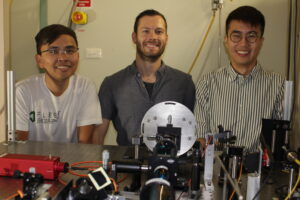
FLEET Research Fellows and ANU researchers: from left Dr Eliezer Estrecho, Dr Matthias Wurdack, Dr Tinghe Yun (Credit: Phil Dooley ANU)
First published Australian National University
A surprise observation of negative mass in exciton-polaritons has added yet another dimension of weirdness to these strange light-matter hybrid particles.
Dr Matthias Wurdack, Dr Tinghe Yun and Dr Eliezer Estrecho from the Department of Quantum Sciences and Technology (QST) were experimenting with exciton polaritons when they realised that under certain conditions the dispersion became inverted – equating to a negative mass.
To add to the surprise, the unexpected cause has turned out to be losses.
“We did not expect that – the dispersion followed very unconventional behaviour,” said Dr Wurdack, who is a member of the FLEET as well as QST.
An exciton is formed from an electron and a hole pairing up in a semiconducting crystal. If this pair then strongly couples to a photon, a hybrid particle known as an exciton-polariton can form.
Exciton-polaritons were first observed more than 30 years ago and have been shown to exhibit remarkable properties, including superfluidity and formation of Bose-Einstein condensates. Around the world a number of research groups are exploring the counter-intuitive behaviour of these strange particles in the hope they could underpin future low-energy technologies.
The observation of negative mass sent the scientists, from the group of Professor Elena Ostrovskaya, back to the whiteboard to try to work out what could cause such an effect.
The simplicity of the experiment, a monolayer of tungsten disulfide integrated in a microcavity, meant that it could be approximated with a simple coupled-oscillator model and so left few possibilities for unexpected effects. The team soon realised an imaginary coupling constant, called dissipative coupling, in their calculations replicated their observations.
However, they struggled to make sense of the mathematical model, until they looked at other fields, such as microwave cavities, and realised that an imaginary coupling constant could equate to losses from the light-matter system.
To confirm that interpretation, the team reached out to experts in numerical modelling of physics in two-dimensional systems, led by Professor Andreas Knorr from Technical University of Berlin in Germany. Manuel Katzer and Dr Malte Selig from his team were able to confirm that the negative mass could arise from losses – specifically due to interactions between exciton-polaritons and phonons in the atomically-thin semiconductor.
The calculations also showed that as the exciton-phonon interactions were turned off, the mass went from positive to negative, behaviour that subsequent experiments at ANU reproduced. The results are now published in Nature Communications.
Dr Wurdack likened the behaviour of exciton-polaritons to that of boats on a lake.
“The phonons in the active material are like waves on the lake which can affect the movement of the boats – redirecting them, causing them to sway and capsize. This reduces their kinetic energies, which overall leads to losses in momentum, energy and occupation numbers,” he said.
In the quest for low-energy technology, scientists go to great lengths to reduce or remove losses, said Dr Estrecho, also from FLEET.
“Typically, we don’t want losses, but here losses have given us something new,” he said.
“It enabled us to introduce a negative mass to the strongly coupled system.”
The discovery is another facet of exciton-polaritons’ counter-intuitive behaviour, Dr Wurdack said.
“This behaviour could be used for dispersion engineering, potentially to probe new physics and create as yet undreamed-of devices.”
“I cannot predict the extent of future applications yet using this kind of dispersion engineering, but I am hopeful this will be explored in future research activities,” he said.
Negative-mass exciton polaritons induced by dissipative light-matter coupling in an atomically thin semiconductor was published in Nature Communications in February 2023 DOI 10.1038/s41467-023-36618-6
Contact Dr Matthias Wurdack matthias.wurdack@anu.edu.au

